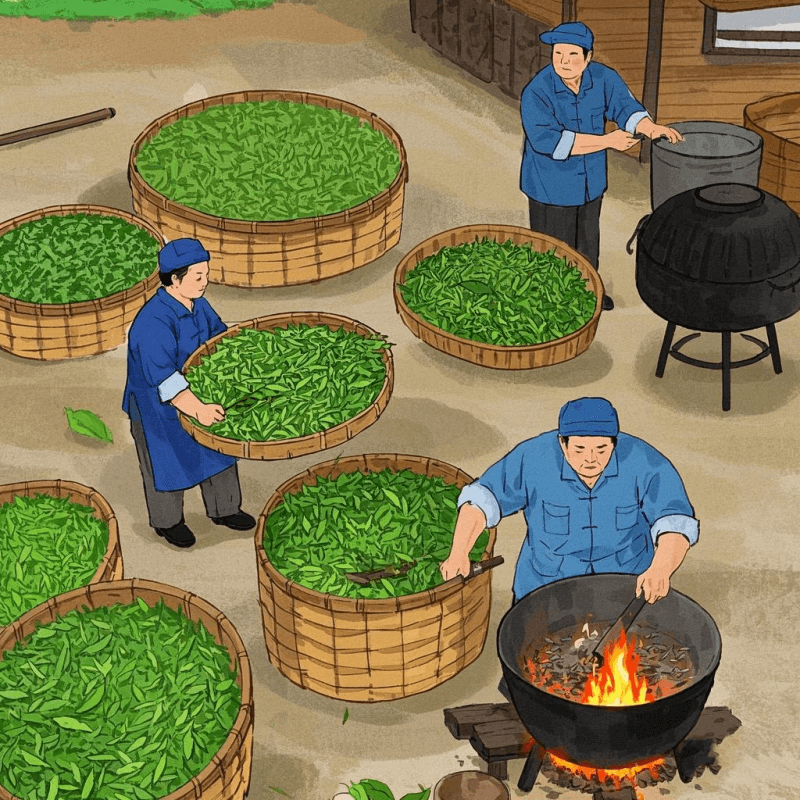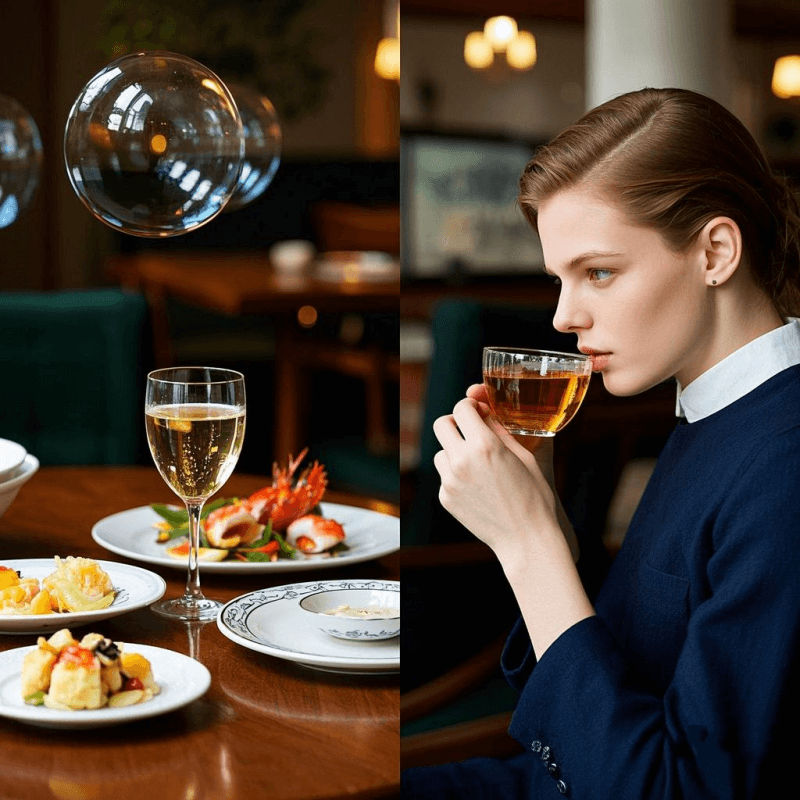What is Oolong Tea: The Perfect Balance Between Green and Black Tea

Basic Definition & Production Process
Oolong tea represents one of the most sophisticated categories in the tea world, occupying the fascinating middle ground between green and black tea with an oxidation level ranging from 8% to 80%. This semi-oxidized tea undergoes a complex production process involving withering, partial oxidation, rolling, and firing, creating a diverse spectrum of flavors that can range from light and floral to deep and roasted.
The oxidation process is carefully controlled through techniques like “shake and bake” (摇青), where tea leaves are gently bruised and then allowed to oxidize partially before being heated to halt the process. This meticulous craftsmanship results in the characteristic complexity that makes oolong tea so prized among connoisseurs.
Representative Types Overview
- Tie Guan Yin (Iron Goddess): Known for its floral aroma and creamy texture, typically lightly oxidized (15-25%)
- Wuyi Rock Teas (Da Hong Pao and others): Famous for their distinctive “rock flavor” (岩韵) and mineral complexity
- Phoenix Single Bush (Feng Huang Dan Cong): Celebrated for their incredible variety of natural fragrances mimicking fruits, flowers, and spices
- High Mountain Oolongs (Dong Ding, Jin Xuan): Taiwanese varieties known for their buttery mouthfeel and high-altitude terroir
Flavor Profiles & Signature Characteristics
The magic of oolong lies in its diverse flavor expressions. “Rock flavor” (岩韵) in Wuyi teas comes from the unique mineral composition of the region’s volcanic soil. Floral and fruity notes develop through careful oxidation management, while the natural milk fragrance in varieties like Jin Xuan results from specific cultivars and processing techniques rather than artificial flavoring.
2025 Trends & Market Opportunities
Non-Alcoholic Sparkling Tea: Oolong x Intelligent Food Pairing
The sophisticated food pairing movement has embraced oolong-based sparkling teas as elegant alternatives to wine. High-end restaurants are now featuring oolong sparklers that complement seafood, light proteins, and artisanal desserts. The complex tannin structure of aged oolongs provides the backbone needed for serious food pairing, while carbonation adds a festive element that appeals to health-conscious consumers.
Leading establishments are creating signature oolong sparklers using cold-extracted tea bases combined with natural carbonation, offering multi-course pairings that rival traditional wine service.
Bubble Tea Evolution: Oolong as Premium Base

The global bubble tea market, valued at over $2.4 billion, is increasingly embracing oolong varieties as premium bases. Specialty shops are featuring honey oolong, grapefruit oolong, and lemon oolong combinations, with high-quality single-origin teas like Duck Shit Fragrance Dan Cong commanding premium prices.
This trend reflects consumers’ growing appreciation for authentic tea flavors and willingness to pay more for quality ingredients in their favorite beverages.
New Tea Houses & Social Scene Migration
Modern tea culture is experiencing a renaissance among younger demographics, with oolong playing a central role in alcohol-free social spaces. Evening tea services featuring premium oolongs are becoming popular alternatives to traditional bar culture, especially among health-conscious millennials and Gen Z consumers who prioritize wellness without sacrificing social experiences.
Industry & Supply Side Challenges
Climate change is significantly impacting traditional oolong production regions, affecting harvest timing and flavor development. Consumers are learning to appreciate vintage variations and batch differences as natural expressions of terroir rather than quality inconsistencies. This shift in perception is creating opportunities for tea producers to educate consumers about the artisanal nature of oolong production.
Health Benefits & Scientific Evidence
Metabolic Health Research
Recent systematic reviews suggest that oolong tea’s unique combination of polyphenols and caffeine may support metabolic health. Studies indicate potential benefits for weight management, with some research showing modest effects on fat oxidation and energy expenditure. However, evidence quality varies, and effects are generally modest compared to lifestyle interventions.
The polyphenol content in oolong, particularly theaflavins and catechins, shows promise in preliminary studies for supporting cardiovascular health, though more human trials are needed to establish definitive benefits.
Cognitive & Mood Effects
The synergistic relationship between L-theanine and caffeine in oolong creates a unique cognitive profile characterized by calm alertness. This combination can promote focused attention without the jittery side effects often associated with coffee consumption.
To maximize L-theanine extraction, brew oolong at moderate temperatures (185-195°F) for 3-5 minutes. Higher temperatures and longer steeping times increase caffeine extraction more than L-theanine, potentially disrupting the balanced effect.
Important Considerations
Individuals sensitive to caffeine should be aware that oolong typically contains 50-75mg of caffeine per 8oz serving. Consuming oolong on an empty stomach may cause digestive discomfort in some people. Those taking medications, particularly blood thinners or blood pressure medications, should consult healthcare providers about potential interactions.
Smart Shopping Guide & Avoiding Common Pitfalls
Understanding Origin & Batch Information
Quality oolong producers provide detailed origin information including specific mountain areas, harvest dates, and processing details. For Wuyi rock teas, legitimate products should specify the exact cliff area and rock formation. Phoenix Dan Cong teas should indicate the specific bush type and fragrance profile.
Always look for harvest year information, as oolong quality can vary significantly between seasons due to weather conditions and processing variations.
Evaluating Craftsmanship & Roasting Levels
Oolong roasting levels dramatically affect flavor profiles:
- Light roast: Preserves floral notes and bright acidity
- Medium roast: Balances floral and toasted characteristics
- Heavy roast: Develops deep, caramelized flavors with reduced astringency
Quality indicators include uniform leaf appearance, absence of excessive stems or broken pieces, and appropriate color consistency for the stated roasting level.
The “Milk Oolong” Controversy
Authentic milk oolong (Jin Xuan) develops its creamy characteristics through specific cultivar genetics and processing techniques. Beware of artificially flavored versions that use external milk flavoring. Genuine milk oolong should have subtle, integrated creamy notes rather than obvious artificial dairy flavoring.
Red flags include overpowering milk aroma, artificial vanilla notes, or prices significantly below market rates for authentic Jin Xuan.
Online Purchasing Best Practices
Reputable vendors provide:
- Detailed origin and processing information
- Laboratory testing reports for pesticide residues
- Clear return and exchange policies
- Proper storage recommendations
- Contact information for customer service
Be wary of vendors making exaggerated health claims or selling rare varieties at unusually low prices.
Brewing & Extraction Methods: Hot, Gongfu, Cold, and Sparkling
Standard Home Brewing Guidelines
For consistent results, use these baseline parameters:
- Water temperature: 185-205°F (depending on oxidation level)
- Tea-to-water ratio: 1 teaspoon (2-3g) per 6-8oz water
- Steeping time: 3-5 minutes for first infusion
- Multiple infusions: Increase time by 30-60 seconds per subsequent brewing
Higher oxidation oolongs can handle hotter water and longer steeping times, while lighter oolongs require more delicate treatment.
Cold Brew Oolong: Accessibility & Versatility
Cold brewing opens oolong to broader audiences by reducing astringency and caffeine content while preserving delicate flavors. Use a 1:20 tea-to-water ratio and steep for 6-12 hours in refrigeration.
Batch preparation tip: Prepare concentrated cold brew (1:10 ratio) and dilute as needed. Cold brew oolong concentrates keep well for 3-4 days refrigerated.
DIY Non-Alcoholic Sparkling Tea
Create restaurant-quality sparkling oolong at home:
- Cold extract base: Steep oolong at 1:15 ratio for 8 hours
- Carbonation options:
- SodaStream or similar carbonation device
- Mix with high-quality sparkling water (1:1 to 1:2 ratio)
- Flavor enhancement: Add citrus oils, white flower waters, or tropical fruit essences
Recommended flavor combinations:
- Light oolongs + citrus + white flower notes
- Medium roast oolongs + stone fruit + herb infusions
- Dark oolongs + tropical fruits + spice accents
Oolong Food Pairing & Non-Alcoholic Dining
Seafood & Light Proteins
Light oolongs complement delicate seafood preparations, enhancing rather than overwhelming subtle flavors. The natural salinity in some rock oolongs creates beautiful harmony with shellfish and crustaceans.
Medium-roast oolongs pair excellently with chicken, pork, and game birds, with the tea’s complexity matching the protein’s richness without competing.
Pasta & Dairy-Based Dishes
The creamy texture of certain oolongs, particularly high-mountain varieties, creates surprising synergy with cream-based pasta dishes and soft cheeses. The tea’s natural sweetness balances rich dairy flavors while cleansing the palate.
Sparkling Oolong as Aperitif
Lightly oxidized sparkling oolongs make excellent appetite stimulants, with their effervescence and subtle astringency preparing the palate for complex flavors to follow. Serve chilled with light appetizers or fresh fruit.
Sustainability & Origin Stories
Climate Change Impact on Oolong Terroir
Traditional oolong regions are experiencing significant environmental changes affecting harvest timing, flavor development, and annual yields. Temperature shifts alter the delicate balance of chemical compounds that create signature flavor profiles.
Understanding vintage variation helps consumers appreciate oolong as an agricultural product subject to natural forces rather than expecting industrial consistency. This perspective adds depth to the tea drinking experience and supports sustainable farming practices.
Global Expansion & Innovation
Japanese tea producers are increasingly experimenting with oolong production, bringing unique perspectives to traditional processing methods. These innovations reflect oolong’s global appeal and potential for continued evolution while respecting traditional craftsmanship principles.
Supporting diverse oolong producers helps maintain genetic diversity in tea cultivars and processing techniques essential for long-term sustainability.
Frequently Asked Questions
How much caffeine does oolong tea contain, and when is the best time to drink it?
Oolong typically contains 50-75mg of caffeine per 8oz serving, roughly half that of coffee. The combination with L-theanine creates sustained energy without crashes, making it suitable for morning or early afternoon consumption. Avoid drinking within 6 hours of bedtime if you’re caffeine-sensitive.
Does cold brewing reduce caffeine and astringency?
Yes, cold brewing extracts approximately 30-40% less caffeine than hot brewing and significantly reduces tannins that cause astringency. Cold brew oolong stays fresh for 3-4 days refrigerated and can be diluted to taste.
Can I rely on tea for weight loss or blood sugar control?
While some studies suggest modest metabolic benefits from oolong consumption, tea should be considered a supportive element rather than a primary intervention. The evidence quality is moderate, and effects are generally small compared to diet and exercise modifications. Always consult healthcare providers for medical concerns.
Is oolong in milk tea healthier than other bases?
The health impact of milk tea depends primarily on added sugars, dairy choices, and portion sizes rather than the tea base. While oolong may provide more antioxidants than black tea, the added ingredients typically dominate the nutritional profile of finished beverages.
The sophistication and versatility of oolong tea continue to drive innovation in both traditional tea culture and modern beverage applications. As consumers become more educated about quality indicators and brewing techniques, oolong’s position as a premium tea category becomes increasingly secure. Whether enjoyed in traditional gongfu style or as part of contemporary culinary experiences, oolong tea offers endless opportunities for exploration and appreciation.
